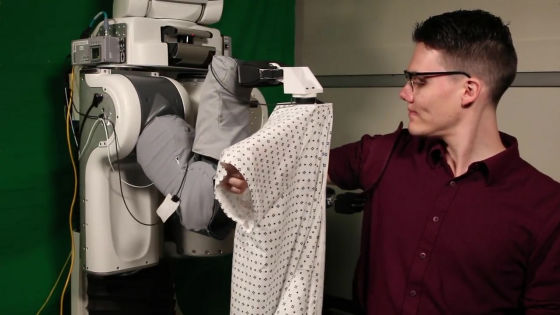The appearance that "the robot that puts on clothes" actually wears clothes looks like this

Various robots that do simple and annoying work instead of human beings are being developed, but in the United States "Robots that dress up" are being developed. By using machine learning technology, we understand "How to put on clothes that people feel comfortable" with the explosion speed.
Robot Teaches Itself How to Dress People
http://www.news.gatech.edu/2018/05/14/robot-teaches-itself-how-dress-people
Robots that can safely and smoothly dress can be checked with the following movie.
Robot Puts Hospital Gown on a Person - YouTube
Having a shirt beyond the person who presented the arm, the robot "PR 2" dressed in clothes

With a slow motion, I succeeded in passing the shirt through my arm.

PR2 has learned how to put the best clothes (precisely how to pass the arm) by machine learning the result of the clothing test by the robot arm which was experimented more than 10,000 times.

Depending on the position, speed and rhythm of pulling clothes, the shirt is caught in the arm, but while PR2 is a slow movement, I will pass the shirt through the arm quite smoothly.

The PR2 was developed by the research team of Zakkori Ericsson of the Georgia Institute of Technology.

Had already been done(PDF file)Experimental results of "Researching clothes by robot arm"It is said that the robot learned how to put on clothes by diverting it.

Machine learning data on the relationship of 'comfort of clothing' which changes according to how to put in force in a conventional experiment conducted 11,000 times, DP 2 is felt by human beings to be comfortable by data analysis of only one day He seems to have succeeded in understanding "how to put on clothes".

According to Mr. Ericsson, "Although humans acquire new skills while trial and error, I gave PR2 the same opportunity as this," he said. In addition, research has also explored optimization of thinking time of robot, and it seems that the probability of failing increases when the time to predict the next movement is less than 0.5 seconds.

"The more robots you learn about us, the more robots will be able to help you better," said Charlie Kemp, associate professor at the Georgia Institute of Technology.

It takes about 10 seconds for PR2 to shirt a shirt in his arm. In addition, it is only at the article creation time that you can put a shirt through one arm. The road to practical application of a robot that accurately and safely carries clothing assistance to the end seems to be far apart, but "robots that dress up" will greatly reduce the burden on people at medical institutions and nursing care facilities It is expected.

Related Posts:







